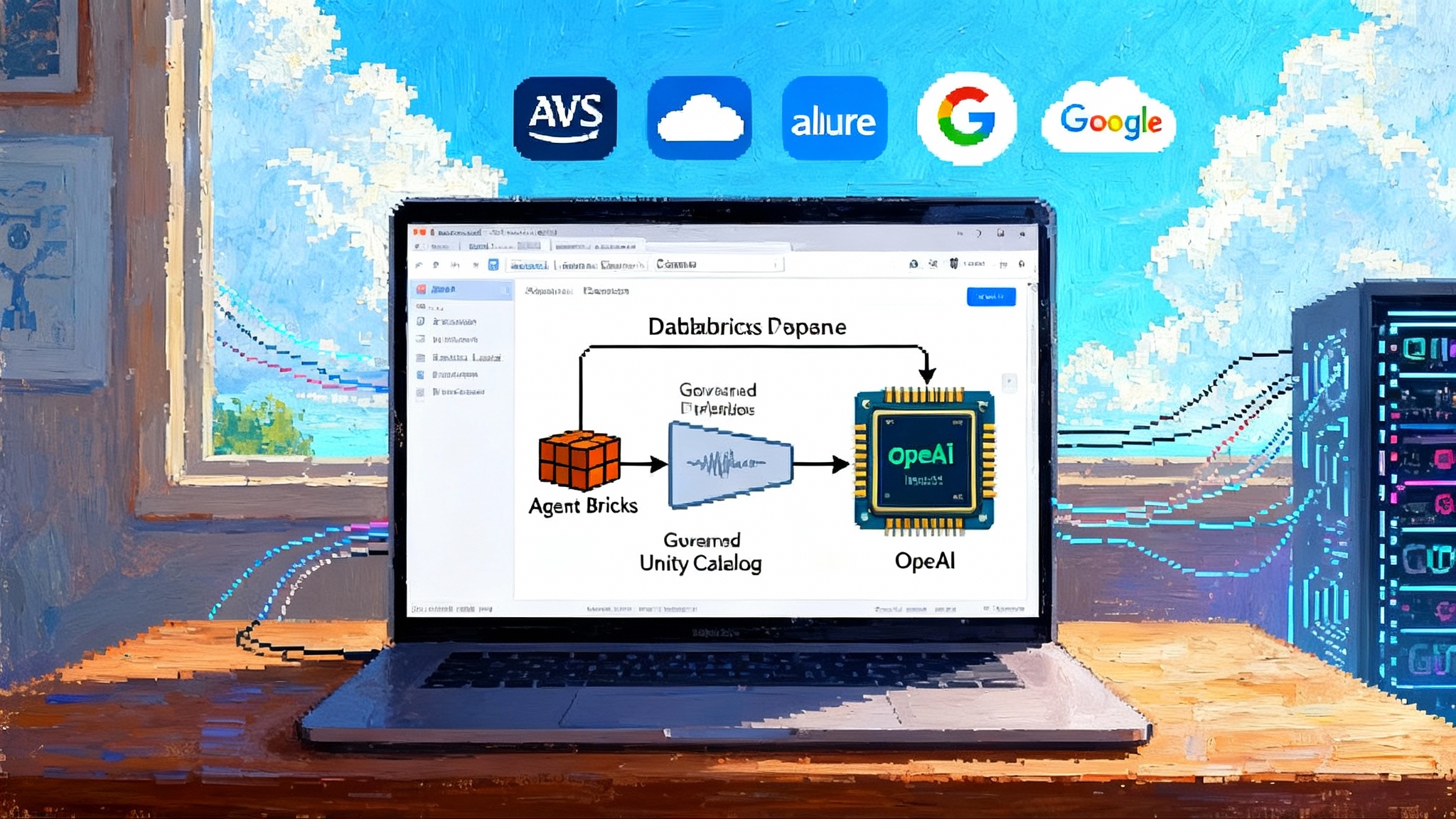Databricks and OpenAI: $100M Data‑Native Agents Go Live
Databricks is embedding OpenAI’s latest reasoning models directly into its Data Intelligence Platform and Agent Bricks, giving enterprises governed, high-capacity agents that work on in-place data. Here is what the deal changes, how to ship value in 90 days, and what to watch next.

The enterprise AI moment moves from demos to deployment
On September 25, 2025, Databricks and OpenAI announced a multiyear, $100 million partnership that makes OpenAI’s frontier reasoning models available natively inside the Databricks Data Intelligence Platform and Agent Bricks. Customers can select models like o3 and o4-mini today, with GPT-5 positioned as a flagship option as it becomes broadly available. The move shifts many teams from proof of concept to production by consolidating model access, governance, and evaluation where the data already lives, as outlined in the Databricks OpenAI partnership announcement.
What data-native agents actually mean
Data-native agents are built, evaluated, and governed next to your tables, features, tools, and policies. In practical terms on Databricks, that looks like this:
- Unified governance with Unity Catalog. Tables, vector indexes, models, prompts, evaluation datasets, and registered tools share one catalog with fine-grained permissions, masking, and lineage. Security and compliance teams get a single system of record for agent behavior and data access.
- Model access on platform. OpenAI models appear inside the platform so builders can call them from SQL or APIs without plumbing separate inference services or copying data to external systems by default. Capacity is provisioned with dedicated high-capacity guarantees.
- Build-evaluate-tune loop with Agent Bricks. You specify the problem and the data. Agent Bricks scaffolds an agent system, compares models, tunes where allowed, and runs automatic, task-specific evaluations with LLM judges and human-in-the-loop review. Results, costs, and tradeoffs are logged for reproducibility and rollback.
- Tools and actions with governance. Agents call governed tools registered in Unity Catalog, bringing approvals and lineage to function calling, code execution, external API calls, and retrieval steps.
- Zero-copy data partnerships. Through Marketplace and Delta Sharing, third-party datasets can be brought into the agent context without ETL sprawl, which shortens time to insight and preserves lineage.
The model lineup matters as much as the mechanics. OpenAI’s o-series models emphasize step-by-step problem solving and tool use with speed and cost profiles suited to production agents. They handle STEM reasoning, code, long context, browsing, Python, and vision. GPT-5 is framed as a higher-reasoning option for the hardest problems as it rolls out.
Why this reduces integration risk and data movement
Most enterprise AI demos break during security reviews. Shipping data to external inference services, stitching separate eval pipelines, and duplicating governance across systems creates failure points and audit gaps. Data-native agents invert that by keeping the center of gravity on platform:
- Policies and lineage travel with the agent because inputs, outputs, prompts, function calls, and side effects are cataloged and permissioned.
- Evaluation data and metrics sit next to production data, so the same role-based controls apply to test sets that drive model decisions.
- Capacity is contracted up front, lowering the risk of rate limits or traffic shaping when agents move from pilot to production.
The net is fewer moving parts and fewer places where sensitive data can leak. That is the difference between a clever prototype and an app your risk committee will approve.
A multi-model, multicloud strategy that predates OpenAI
The OpenAI pact follows 2025 agreements to bring Anthropic’s Claude models and Google’s Gemini models natively onto the platform. Together with OpenAI, this signals a clear multi-model posture rather than a single-vendor bet. For broader context on multi-model enterprise patterns, see the multi model enterprise playbook.
Competitive implications
- Snowflake. Expect a feature race on agent evaluation, tools governance, and data sharing across clouds. Databricks raises the bar on capacity guarantees and on-platform tuning, while Snowflake’s tight Microsoft integration can appeal to Microsoft 365 and Teams centric shops.
- Microsoft and distribution. Microsoft remains a key OpenAI partner, while 2025 developments opened the door for broader model distribution across platforms and clouds.
- AWS-first stacks. For teams standardizing on Bedrock, SageMaker, or native AWS data services, Databricks plus on-platform OpenAI access creates a pragmatic alternative that limits cross-cloud egress. For more on AWS’s approach to agents, read the AWS Quick Suite overview.
Net net, the winner in this phase will be the platform that makes agents easy to ship under governance, not the platform with the single highest benchmark.
The quiet unlocks: capacity guarantees and evaluation pipelines
The hard parts of enterprise AI are stability, accuracy, and accountability under load.
- Capacity guarantees. Dedicated high capacity lets you plan throughput for quarterly close, holiday call surges, or batch agent runs without surprise throttling. The commercial commitment signals reserved GPU time for enterprise workloads, as noted in TechCrunch coverage of the deal.
- Evaluation and tuning. Agent Bricks bakes in task-specific evals with LLM judges, cost tracking, and human review. Teams can compare multiple models, fine-tune where allowed, and log everything for version-to-version diffs.
- Tools catalog and governance. Registering tools in Unity Catalog lets you approve which external actions an agent may take and see lineage when it does, so you can answer who did what, when, and with which data.
Adoption playbook: how to get value in 90 days
Start with use cases that create measurable value and have bounded domains and tolerances.
- Align on the agent pattern
- Retrieval and summarization for operations and customer support
- Structured extraction from invoices, contracts, or clinical notes
- Code assistant for data engineers and analytics teams
- Analyst copilot that turns SQL warehouses, notebooks, and BI dashboards into natural language interfaces
- Financial research and risk analysis when paired with high-quality market data
- Stand up the build-evaluate-tune loop
- Register data and tools in Unity Catalog, define PII policies and column masks, and turn on lineage
- Create eval sets from real world tickets, docs, or queries, and define pass-fail metrics tied to business outcomes
- Use Agent Bricks to scaffold, compare models, and track cost versus quality as first-class metrics
- Gate promotion with red team prompts, human review, and shadow traffic
- Prepare MLOps for agents
- Standardize on model registries and policy bundles in Unity Catalog
- Automate canary deploys and rollback for agent versions
- Route to a fallback model for spike handling or provider outages
- Monitor conversation quality, tool call outcomes, cost per task, and data drift in production
- Control costs from day one
- Cap serverless budgets per workspace and set per-team budgets for model serving
- Cache prompts and retrieval results where safe, and use lower cost models for easy tasks while escalating to higher reasoning models for hard cases
- Use partial evaluation every release to avoid full test runs unless a threshold is exceeded
Target proof points in 4 to 6 weeks, then scale the winning workflows. For related execution patterns, see how agentic coding goes mainstream.
Pitfalls to avoid
- Evaluation leakage. If eval data leaks into training or fine-tuning sets, scores will overstate quality. Lock eval tables, hash and version them, and audit access.
- Lineage blind spots. If agents call external tools outside the catalog, you lose traceability. Require tool registration and deny unregistered outbound calls.
- Safety gaps. Reasoning models can chain actions with unforeseen side effects. Enforce allowlists, add human approval steps for risky actions, and red team prompts before every promotion.
- Vendor lock-in. Keep a multi-model posture so you can switch models for cost, quality, or policy reasons.
- Governance drift across clouds. If you run across AWS, Azure, and Google Cloud, ensure policies and lineage are enforced uniformly, including tables governed outside your primary workspace.
Near-term signals to watch
- Financial data partnerships in production. Look for early financial institutions that publish results from building agents on natively delivered market data.
- Accelerator cohort launches. Databricks’ new AI Accelerator Program is seeding agent startups. Expect reference apps and blueprints to spread across the customer base.
- Pricing and throughput SLAs. Watch for formal throughput and latency SLAs for OpenAI models inside Databricks, plus clear egress terms.
- First production case studies. Expect early showcases in healthcare, financial services, and manufacturing where quality and governance are make or break.
The bottom line
This partnership marks a shift in the center of gravity for enterprise AI toward governed data platforms. The models get the headlines, but the operational details are the real unlock: Unity Catalog for control, Agent Bricks for the build-evaluate-tune loop, and capacity guarantees so your agents do not throttle when the business depends on them.








